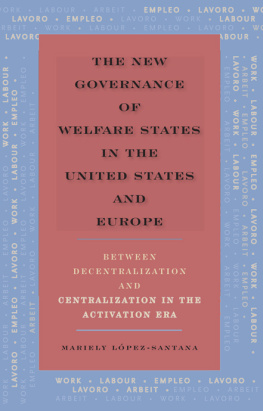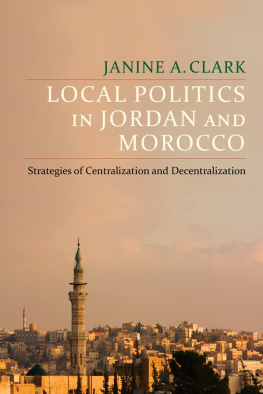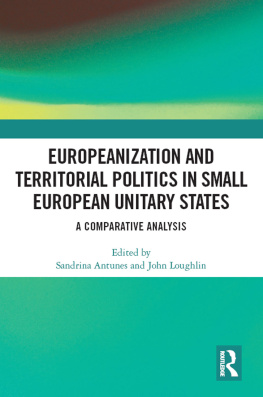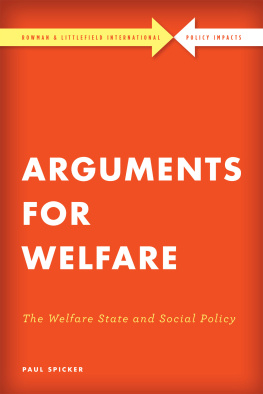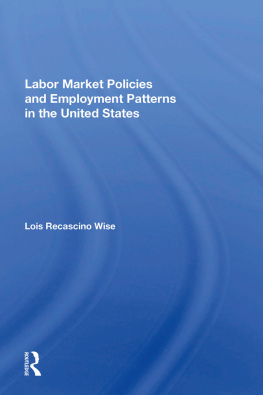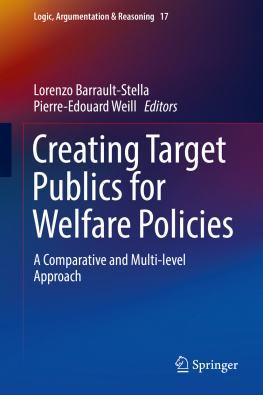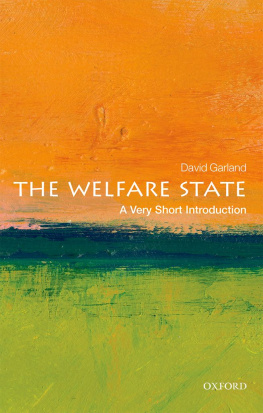Published by State University of New York Press, Albany
2015 State University of New York
All rights reserved
Printed in the United States of America
No part of this book may be used or reproduced in any manner whatsoever without written permission. No part of this book may be stored in a retrieval system or transmitted in any form or by any means including electronic, electrostatic, magnetic tape, mechanical, photocopying, recording, or otherwise without the prior permission in writing of the publisher.
For information, contact State University of New York Press, Albany, NY
www.sunypress.edu
Production, Ryan Morris
Marketing, Kate R. Seburyamo
Library of Congress Cataloging-in-Publication Data
Lpez-Santana, Mariely, 1973
The new governance of welfare states in the United States and Europe : between decentralization and centralization in the activation era / Mariely Lpez-Santana.
pages cm
Includes bibliographical references and index.
ISBN 978-1-4384-5467-2 (hardcover : alk. paper)
ISBN 978-1-4384-5469-6 (ebook)
1. Public welfare administrationUnited States. 2. Public welfare administrationEuropean Union countries. 3. Welfare stateUnited States. 4. Welfare stateEuropean Union countries. 5. Public welfareUnited States. 6. Public welfareEuropean Union countries. 7. Decentralization in governmentUnited States. 8. Decentralization in governmentEuropean Union countries. I. Title.
| HV95.L727 2015 |
| 361.6'5094dc23 | 2014007254 |
10 9 8 7 6 5 4 3 2 1
Contents
C HAPTER 1
Between Unity and Flexibility: An Introduction to the Institutional Reconfiguration of Active Welfare States in Europe and the United States
C HAPTER 2
Activation and Its Implications: Situating the Project
C HAPTER 3
Favoring Subnational Flexibility over Standardization: Extensive Decentralization in Italy and the United States
C HAPTER 4
Balancing Subnational Flexibility and National Unity: Decentralization in Spain and the United Kingdom
(with Milena Bchs)
C HAPTER 5
Flexibility Within Centralization: The German Case
(with Milena Bchs)
C HAPTER 6
The Intergovernmental and Governance Reconfigurations of Active Welfare States: Summary and Implications
Preface
Since the early twentieth century, the provision of social benefits has been one of the main tasks of modern states, especially of central levels of government. In advanced democracies, after decades of growth and prosperity, the 1970s marked the end of the Golden Age era of welfare states. Accordingly, scholars attempting to understand welfare changes have mainly concentrated on transformations in the nature of social policies and their level of generosity. But since the mid-1990s, a parallel trend started to developmany advanced democracies matched policy reforms with substantial changes in the postwar organization of welfare policy responsibilities; thus, illustrating that changes in the content of policy are often matched by intergovernmental and governance reforms, including decentralization and (re-)centralization.
I first learned about these reforms in the early 2000s when I was conducting interviews for my dissertation on the Europeanization of employment policy. As Spanish interviewees talked about the influence of the European Union on the welfare state, they also referred to how competencies were being reallocated to their subnational levels, the Comunidades Autonmas. Years later, as I delved into this topic, I quickly recognized that many countries were following similar paths. For example, the well-known US episode that ended welfare as we knew it in 1996 included the devolution of welfare responsibilities to the states. Canada followed a similar trend when its provinces and territories gained autonomy over active labor market policies in 1996. Five years later, Italy changed its constitution to formalize the decentralization of various welfare competencies to its regions. Similarly, 2010 marked the end of a constitutional reform which reconfigured welfare competencies in Germany. Belgium also changed its constitution to provide regions with more autonomy over labor market policies. Other countries, such as Denmark, Finland, the Netherlands, and Sweden, have also jumped on the reconfiguration bandwagon, which have been actively promoted by the Organization for Economic Co-operation and Development (OECD) and the European Union.
These unprecedented reforms in the territorial configuration of welfare states drove my interest in this topic. More specifically, I wanted to understand the nature and extent of these intergovernmental and governance shifts, as well as their implications. As I researched this topic, I quickly learned that the allocation of social policies responsibilities tells us much about the nature of a welfare state in a particular country and in a particular time. Furthermore, I understood that parallels processes of supranationalization, centralization, decentralization, and delegation were not contradictory in nature, as states seek to find their own balance between the introduction of flexibility, on the one hand, and the promotion of national standards and cohesive policy approaches, on the other hand. The tensions between unity and flexibility are especially salient in the welfare area. As Gallego and Subirats (2011, 99) clearly put it, If decentralization has tended to be interpreted as process that can help improve the quality and responsiveness of welfare policies, for some it can also endanger equity because of the dynamics of differentiation and the generation of inequalities that this entails.
This book is written with three main audiences in mindthose who are interested in contemporary welfare state changes; those who are fascinated by the dynamics of power reallocations (e.g., decentralization, centralization, delegation) in federal, regional, and unitary states; and those who study new modes of governance and new public management. In this way, the book links studies of polity structures with the literatures on contemporary welfare state changes and governance changes by drawing attention to: (1) how intergovernmental and governance welfare arrangements have changed across OECD countries; (2) how states struggle with having unified social policy approaches, on the one hand, and increasing flexibility to promote localized and personalized social measures, on the other hand; and (3) how states solve the tensions between unity and flexibility.
But beyond these audiences, why should others care about the findings of this book? First, this study speaks directly to the tensions faced by any type of political system (i.e., federal, regionalized, unitary) regarding how to bring policies closer to people, while maintaining cohesive policy approaches across the country. By exploring a variety of institutional and governance solutions to this paradox, the book shows that while there are salient cross-national variations in the types of reforms, there are also common cross-national trends regarding how states tackle the tensions between unity and flexibility. Second, this book puts on the table relevant questions regarding interterritorial inequalities and territorial justice in an era of welfare change. Given common downward trends, should national levels retain certain powers to guarantee social citizenship and fairness across the territory as Obinger, Liebfried, and Castles (2005, 3) imply when they state, Central to the idea of social protection is the provision of nation-wide uniform social rights that supplement basic civil and political rights? Or, in light of high levels of labor market inactivity, should efficacy and efficiency through the introduction of flexibility trump these matters? While these questions are not completely resolved by the book, the findings presented here surely have important analytical, theoretical, and normative implications, especially when taking into account common cross-national decentralization and devolution trends across a variety of policy areas.

